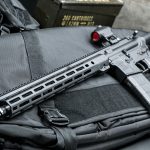Net income for the quarter included a non-cash, fair-value adjustment to the contingent consideration liability related to our acquisition of USR that increased fully diluted earnings per share by $0.02 in the quarter. Without that adjustment, net income for the quarter would have been $1.1 million, or $0.02 per fully diluted share.
Michael F. Golden,
For the third quarter of fiscal 2010, gross profit of $25.0 million, or 28% of sales, was 16% higher than gross profit of $21.5 million, or 26% of sales, for the third quarter last year.
Adjusted EBITDAS, a non-GAAP financial measure, was $6.5 million for the third quarter compared with adjusted EBITDAS of $9.2 million for the comparable quarter last year. On a year-to-date basis, adjusted EBITDAS was $43 million versus $26 million last year.
William F. Spengler, Executive Vice President and Chief Financial Officer, said, “Firearms division sales decreased by 11.0% versus the year ago quarter. Revolver sales decreased 19% because of limited inventory at the beginning of the quarter, combined with a return to more normal levels of demand in the industry. Overall pistol sales decreased 33%, partially as a result of declining industry demand. While sales of our Sigma line of polymer pistols declined 63% year-over-year, sales of our premium M&P polymer pistols declined only 12%. Walther product sales grew by about 8%, aided by the introduction of the PK380 combined with increased production and availability of Walther’s products manufactured in Germany. We achieved 18% growth in tactical rifles in the quarter, driven by the introduction of our new M&P15-22. New product offerings of our Performance Center Pro Series handguns helped drive premium product sales growth of 40%. Hunting products grew in the third quarter, aided by sales of accessories. Sales of black powder rifles achieved a slight increase over the prior year comparable quarter. Thompson/Center Arms branded products continued to perform well, more than offsetting other hunting products sold or closed out in the prior year.”
Firearms order backlog was $74 million at the end of the third quarter, approximately $22 million less than backlog at the end of the second quarter. This reduction in backlog largely reflects cancellations as the market moved toward more normal levels of demand and production.
Perimeter security sales of $15 million for the quarter represented solid growth of over 70% versus the comparable quarter last year, which was prior to our acquisition of USR. Additional perimeter security sales that we had anticipated during the quarter were hampered by a number of severe-weather-related delays in installation projects throughout much of the Eastern United States. Perimeter security backlog at the end of the third quarter was $42.5 million, more than double the comparable quarter last year. Our perimeter security backlog typically represents contracted programs, most of which are not likely to be cancelled.
Gross profit of $25.0 million, or 28% of sales, compares favorably to the year ago quarter, which includes approximately $2.0 million in Walther-related warranty expense. In addition, the current quarter benefitted from reduced promotional spending and improved efficiencies at our Rochester, New Hampshire manufacturing facility. Gross margins were unfavorably impacted by approximately $900,000 of amortization of acquisition-related intangibles from USR business contracted prior to the acquisition and by lower than historical margins on selected USR programs that contained newer product offerings. Gross profit margin in the perimeter security business remained below 30% in the third quarter, prior to purchase accounting adjustments.
Operating expenses of $23 million, or 26% of sales, in the quarter increased versus operating expenses of $17 million, or 20% of sales, for the comparable quarter last year. USR, which was acquired in July 2009, accounted for $3.1 million of the increase in operating expenses. Sales and marketing expense increased by $1.5 million and included higher SHOT Show expenses, increased advertising expense, and research and development costs related to our recently introduced M&P4 fully automatic rifle. We also incurred increased legal and consulting fees of $1.1 million in the quarter related to allegations against one of our employees under the Foreign Corrupt Practices Act. Operating expense increases in the third quarter were partially offset by lower profit sharing and a reduction in accrued bad debt expense.
Inventory levels increased to $47.7 million in our third quarter, compared to $41.7 million at the end of the prior fiscal year, due partly to the inclusion of USR inventory. Accounts receivable increased by $9.0 million to $57 million, compared to $48.2 million at the end of the prior fiscal year. The acquisition of USR added $18.8 million in accounts receivable, which was offset by a $9.0 million reduction related to cyclicality in our firearms business. At the end of the third quarter, we had approximately $37 million in cash and had no borrowings under our revolving line of credit. During the quarter, we paid off $4.8 million of debt, which carried interest costs in excess of 6%. We also expanded our revolving line of credit with TD Bank from $40 million to $60 million, but we have no current plan to draw on that line.
Outlook
Spengler added, “We expect total Company sales for the fourth quarter to be between $97 million and $101 million, approximately flat with the prior year fourth quarter. Within that total, we expect the firearms segment to contribute between $81 million and $84 million, and the perimeter security segment to contribute the balance. Firearms revenue within this range reflects more stable levels of demand and production versus the spike that we experienced in the fourth quarter of fiscal 2009. This range also takes into account the fact that we are currently reviewing our international selling processes, an activity which may reduce international firearms shipments during the quarter.
We expect total company gross profit margin in the fourth quarter will improve to approximately 29%, and we expect fourth quarter operating expenses to be approximately $500,000 higher than our third quarter because of increased profit sharing on improved operating income,” concluded Spengler.















